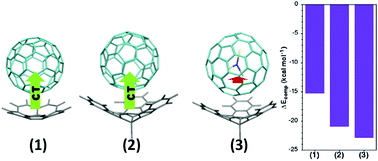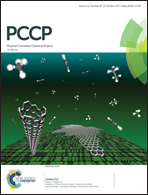A theoretical study of complexes between fullerenes and concave receptors with interest in photovoltaics†
Abstract
The complexation of the pristine fullerenes C60 and C70 and the endohedral fullerenes Sc3N@C80 and Sc3N@C68 has been tested using a series of hosts of different nature, including the buckybowls corannulene and sumanene, a zinc porphyrin, a chloro boron subphthalocyanine, and a corannulene pentasubstituted with nitrile groups. A systematic theoretical study has been carried out in order to explore both the strength of the interaction and the feasibility for electron transfer of the dimers. Dispersion is the main stabilizing contribution in these dimers, so both molecules orientate so as to maximize the number of close contacts among atoms. As a consequence, all host molecules interact with C70 by the long axis. C60 and Sc3N@C80 are more spherically shaped, so there is no clear preference for the position of the host molecule, though endohedral fullerenes are encapsulated preferentially by the face without contacts with the inner cluster. Complexation energies increase with the contact surface between molecules in the complex. The most stable complexes with fullerenes are formed by the subphthalocyanine and the CN-pentasubstituted corannulene. Depending on the dimer, complexation energies span from around −15 kcal mol−1 of C60 with corannulene to −24 kcal mol−1 of Sc3N@C80 with the subphthalocyanine. Some of the dimers seem to be capable of acting as a donor–acceptor pair, leading to charge transfer states with a neat separation of charge, thus being candidates for organic photovoltaic devices. Endohedral fullerenes are less prone to these donor–acceptor transitions, with charge transfer taking place from the carbon cage to the endohedral cluster. cora5CN, with its inverted polarity, also shows charge transfer upon excitation but with the fullerene acting as a donor and the buckybowl as an acceptor.



 Please wait while we load your content...
Please wait while we load your content...